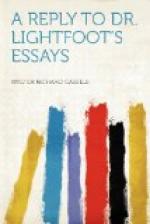The same remark applies to Melito of Sardis. I have fully discussed [135:3] the evidence which he is supposed to contribute, and it is unnecessary for me to enter into it at any length here, more especially as Dr. Lightfoot does not advance any new argument. He has said nothing which materially alters the doubtful position of many of the fragments attributed to this Father. In any case the use which Dr. Lightfoot chiefly makes of him as a witness is to show that Melito exhibits full knowledge of the details of evangelical history as contained in the four canonical Gospels. Waiving all discussion of the authenticity of the fragments, and accepting, for the sake of argument, the asserted acquaintance with evangelical history which they display, I simply enquire what this proves? Does anyone doubt that Melito of Sardis, in the last third of the second century, must have been thoroughly versed in Gospel history, or deny that he might have possessed our four Gospels? The only thing which is lacking is actual proof of the fact. Melito does not refer to a single Gospel by name. He does not add one word or one fact to our knowledge of the Gospels or their composers. He does not, indeed, mention any writing of the New Testament. If his words regarding the “Books of the Old Testament” imply “a corresponding Christian literature which he regarded as the books of the New Testament,” [136:1] which I deny, what is gained? Even in that case “we cannot,” as Dr. Lardner frankly states, “infer the names or the exact number of those books.” As for adding anything to the credibility of miracles, such an idea is not even broached by Dr. Lightfoot, and yet if he cannot do this the only purpose for which his testimony is examined is gone. The elaborate display of vehemence in discussing the authenticity of fragments of his writings merely distracts the attention of the reader from the true issue if, when to his own satisfaction, Dr. Lightfoot cannot turn the evidence of Melito to greater account. [136:2]
Nor is he much more fortunate in the case of Claudius Apollinaris, [137:1] whose “Apology” may be dated about A.D. 177-180. In an extract preserved in the Paschal Chronicle, regarding the genuineness of which all discussion may, for the sake of argument, be waived here, the writer in connection with the Paschal Festival says that “they affirm that Matthew represents” one thing “and, on their showing, the Gospels seem to be at variance with one another.” [137:2] If, therefore, the passage be genuine, the writer seems to refer to the first synoptic, and by inference to the fourth Gospel. He says nothing of the composition of these works, and he does nothing more than merely show that they were accepted in his time. This may seem a good deal when we consider how very few of his contemporaries do as much, but it really contributes nothing to our knowledge of the authors, and does not add a jot to their credibility as witnesses for miracles and the reality of Divine Revelation.




